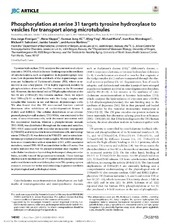Phosphorylation at serine 31 targets tyrosine hydroxylase tovesicles for transport along microtubules
Jorge Finnigan, Ana; Kleppe, Rune; K C, Kunwar Jung; Ying, Ming; Marie, Michael Bruno Eric; Rios Mondragon, Ivan; Salvatore, Michael F; Saraste, Jaakko; Martinez, Aurora
Peer reviewed, Journal article
Published version

Åpne
Permanent lenke
https://hdl.handle.net/1956/17587Utgivelsesdato
2017Metadata
Vis full innførselSamlinger
Originalversjon
Journal of Biological Chemistry. 2017, 292 (34), 14092-14107. https://doi.org/10.1074/jbc.m116.762344Sammendrag
Tyrosine hydroxylase (TH) catalyzes the conversion of L-tyrosine into L-DOPA, which is the rate-limiting step in the synthesis of catecholamines, such as dopamine, in dopaminergergic neurons. Low dopamine levels and death of the dopaminergic neurons are hallmarks of Parkinson's disease (PD), where α-synuclein is also a key player. TH is highly regulated, notably by phosphorylation of several Ser/Thr residues in the N-terminal tail. However, the functional role of TH phosphorylation at the Ser-31 site (THSer(P)-31) remains unclear. Here, we report that THSer(P)-31 co-distributes with the Golgi complex and synaptic-like vesicles in rat and human dopaminergic cells. We also found that the TH microsomal fraction content decreases after inhibition of cyclin-dependent kinase 5 (Cdk5) and ERK1/2. The cellular distribution of an overexpressed phospho-null mutant, TH1-S31A, was restricted to the soma of neuroblastoma cells, with decreased association with the microsomal fraction, whereas a phospho-mimic mutant, TH1-S31E, was distributed throughout the soma and neurites. TH1-S31E associated with vesicular monoamine transporter 2 (VMAT2) and α-synuclein in neuroblastoma cells, and endogenous THSer(P)-31 was detected in VMAT2– and α-synuclein–immunoprecipitated mouse brain samples. Microtubule disruption or co-transfection with α-synuclein A53T, a PD-associated mutation, caused TH1-S31E accumulation in the cell soma. Our results indicate that Ser-31 phosphorylation may regulate TH subcellular localization by enabling its transport along microtubules, notably toward the projection terminals. These findings disclose a new mechanism of TH regulation by phosphorylation and reveal its interaction with key players in PD, opening up new research avenues for better understanding dopamine synthesis in physiological and pathological states.